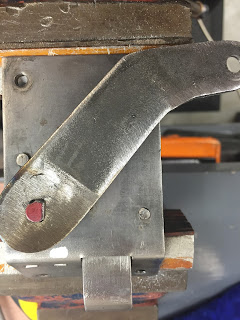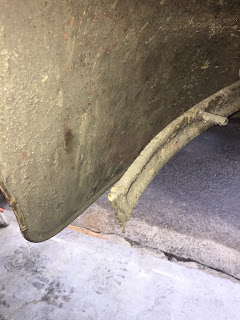There are times when building a rod that you need to understand there are limits to what you can do and this can be for time, a lack of required skills or a lack of required tools.
With things like the boot lid on the Pop (and indeed the repairs to the doors) it just didn't make sense that I should tackle these. Yes I'd love to be able to make panels and roll up a new boot lid skin on an English wheel, but I don't have the skill to do that, the tools to do that or the time to do that.
Yes one day I will go down that track, but not on this project. The self placed deadline is early next year to be back on the road, so it would be futile to even attempt. I think this is where some people go awry with their projects and things go from being a quick paint to a 10 year rebuild or worse still, they never see the light of day again. I can't afford to let that happen as I have a Coupe to get back onto building as soon as the Pop is back on the road.
So off I toddled to Steve Simpson at Panel Restorations in Hillside Road on the North Shore.
Yes I had to pay a wad of cash, but the job is being done and I can keep progressing.This is the inner boot lid after repair.
You can see here the boot lid I had was a bit the worse for the 60 odd years it has been in existence. The rusted piece was cut out and the newly fabricated item installed.
This was the first trial fit to make sure all was well before progressing with fitting a new skin.
Steve made a few more alterations to get everything sitting just right.
You may have seen Steve's truck around. This thing is way cool and despite several offers to buy Steve remains the proud owner!
Look Steve up if you are in the area, even if its just to review the projects he is working on.
Anyway, here it is now all fitted up with the skin installed.
It uses the existing catch but instead of a handle with a square shank into the catch, I will have a cable operated lever on the inside of the lid. To achieve that I have put a bolt through the hole that has one side flattened off with a file. I have put red marker on the end of the bolt to accentuate that for you.
I then made a lever and drilled a hole one end that will go over that bolt. I then welded into that hole on one side and filed it so that the hole has a flat on it to match the bolt. (see hole at bottom of pic)
Here it is on the catch. As you can see, when the lever turns now it will also turn the bolt. On the rear of the catch I tacked the bolt head in place so now as the bolt turns it operates the catch.The reason I used a bolt here rather than a square shank (like the original handle was) is so that I can screw a nut onto the threaded bolt to hold the lever in place. I need the arm to be removable so that I can slide the catch unit out if ever there are any issues with it. I wouldn't be able to do that if I had a lever welded to it.
For the other end I raided a control rod and the nylon fittings from a Japanese car. These nylon fittings just press in.
When you press the rod into the fitting it locks it in place so the nylon fitting wont pull out.
Then the nylon fitting is turned to clip over the rod. Sorted!
There we have it. A lot more robust than what was there before and should be relatively trouble free.
Until next time!










































